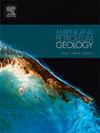Seismic stratigraphy and petroleum prospectivity in the Northern Rovuma Basin, offshore Tanzania
IF 3.7
2区 地球科学
Q1 GEOSCIENCES, MULTIDISCIPLINARY
引用次数: 0
Abstract
The upper slope area of the Northern Rovuma Basin has been poorly studied and little is known about its development and petroleum prospectivity. Interpretation of wellbore, 2D and 3D seismic reflection data in this area has allowed identification of seismic features reflecting key factors for understanding the development of the Cretaceous-Holocene stratigraphy and distribution of petroleum system elements. Our results show that infill of sediment into the basin was due to an interplay of three major factors. These are the sea level variations, extensional tectonics and sediment gravity flows. The Miocene and Pleistocene-Holocene tectonic events triggered gravity flows that supplied sediments to the basin. The resultant deposits include slides, slumps, debrites and turbidites some of which contain potential reservoirs that are interpreted to have been charged by the Permo-Triassic Karoo shales and Cretaceous-Cenozoic source rocks. These reservoirs are contained in both stratigraphic and structural traps with localized combinations in some places, and are encased by deep marine shales. Some of the potential reservoirs are positively inverted and compartmentalized, and they contain several bright and flat spots suggesting hydrocarbon accumulations within the Miocene and Oligocene intervals. It has also been revealed that major gravity flows and bottom currents, that supplied and distributed sediment to the basin, were confined in three long-lived channelized systems that were initiated during the Cretaceous (due to rapid regression), and the Oligocene and Pleistocene periods (due to rapid uplift). The channels migrated toward the southeast, with some shift toward the northeast, and had overall northeast traverse direction perpendicular to the shoreline. The reported gravity flows eroded previously deposited sediment in most places causing several unconformities in the whole Cretaceous-Holocene stratigraphy. Seismic stratigraphic interpretation and facies analysis have proved useful in the identification of key petroleum system elements and improve understanding of sedimentary fill evolution of the study area.
坦桑尼亚近海北罗武马盆地的地震地层和石油远景
对罗武马盆地北部上坡地区的研究很少,对其发展和石油远景知之甚少。通过对该地区的井筒、二维和三维地震反射数据进行解释,确定了反映白垩纪-全新世地层发展和石油系统要素分布的关键因素的地震特征。我们的研究结果表明,沉积物注入盆地是三大因素相互作用的结果。这三个因素是海平面变化、伸展构造和沉积重力流。中新世和更新世-全新世构造事件引发的重力流为盆地提供了沉积物。由此形成的沉积物包括滑坡、坍塌、碎屑岩和浊积岩,其中一些含有潜在的储层,据解释,这些储层是由二叠纪-三叠纪卡鲁页岩和白垩纪-新生代源岩充填而成的。这些储油层包含在地层和构造陷阱中,在某些地方有局部组合,并被深海页岩所包裹。一些潜在储油层呈正倒置和分隔状,其中包含一些亮斑和平斑,表明在中新世和渐新世时期有油气积聚。研究还发现,为盆地提供和分配沉积物的主要重力流和底流被限制在三个长寿命的通道化系统中,这些通道始于白垩纪(由于快速回归)以及渐新世和更新世时期(由于快速隆升)。河道向东南方向迁移,部分向东北方向移动,总体横向为东北方向,与海岸线垂直。所报道的重力流在大多数地方侵蚀了之前沉积的沉积物,导致整个白垩纪-全新世地层中出现若干不整合现象。地震地层解释和岩相分析有助于确定石油系统的关键要素,并提高对研究区域沉积填充演化的认识。
本文章由计算机程序翻译,如有差异,请以英文原文为准。
求助全文
约1分钟内获得全文
求助全文
来源期刊

Marine and Petroleum Geology
地学-地球科学综合
CiteScore
8.80
自引率
14.30%
发文量
475
审稿时长
63 days
期刊介绍:
Marine and Petroleum Geology is the pre-eminent international forum for the exchange of multidisciplinary concepts, interpretations and techniques for all concerned with marine and petroleum geology in industry, government and academia. Rapid bimonthly publication allows early communications of papers or short communications to the geoscience community.
Marine and Petroleum Geology is essential reading for geologists, geophysicists and explorationists in industry, government and academia working in the following areas: marine geology; basin analysis and evaluation; organic geochemistry; reserve/resource estimation; seismic stratigraphy; thermal models of basic evolution; sedimentary geology; continental margins; geophysical interpretation; structural geology/tectonics; formation evaluation techniques; well logging.
 求助内容:
求助内容: 应助结果提醒方式:
应助结果提醒方式:


